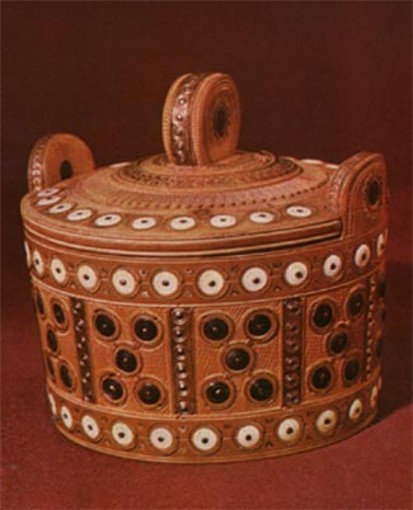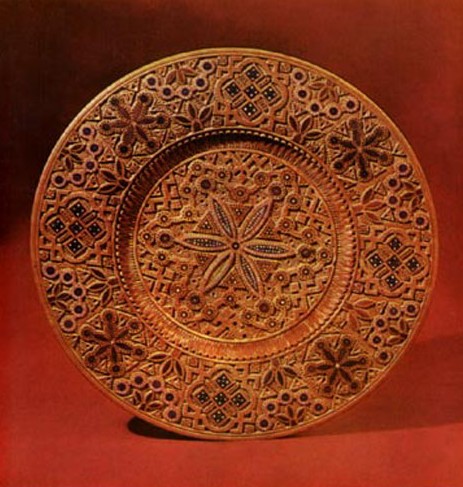Wood carving
Wood carving (різблення художне; rizblennia khudozhne). One of the chief branches of the decorative and applied arts in Ukraine. For many centuries the common people carved wooden plates, spoons, bowls, canes, furniture, cards, sleds, gates, beams, and gables and decorated them with designs organically linked with the practical function of those objects. Richly carved crosses and three-armed candlesticks played an important role in family and religious rituals. The carving of iconostases and church objects, which flourished particularly in the 16th and 17th centuries, was distinct from the popular form of the art. It was mostly thematic and large-scale, and its ornamentation, unlike folk ornamentation, was mostly floral and done in relief. Very few examples of pre-19th-century carving have survived. In the 19th century the influence of larger market forces was profound: carvers began producing purely decorative objects, and middlemen, who organized the distribution of such objects, began demanding new and alien designs. Under Soviet rule wood carving was a highly organized handicraft industry, supported and exploited commercially by the state.
Because of its remoteness, its forest resources, and the artistic talent of its inhabitants the Hutsul region has been by far the leading center of wood carving in Ukraine. The distinctive, traditional Hutsul style was developed further in the 19th and 20th centuries by master carvers, such as the Shkribliak family, Marko Mehedyniuk, and Vasyl Devdiuk. The ornamentation of Hutsul wood carving is flat-carved and geometric. It is enriched with inlays of colored wood, bone, metal wire, mother-of-pearl, and beads. The works of contemporary Hutsul masters, such as the Korpaniuk family, Ivan Balahurak, Mykola Tymkiv, and the Toniuk family, have been sold throughout the world.
In central and eastern Ukraine, folk designs are flat-carved with mostly geometric (rosettes, zigzags, and semicircles) and occasional floral motifs. The incisions are deeper, and the relief is higher. The folk tradition of the Poltava region was popularized in the 19th century by the Yukhymenko family. In the 20th century a number of folk masters turned to thematic carving. Petro Verna, for example, carved portraits of literary characters.
In Transcarpathia Vasyl Svyda has developed a distinct style based on the local tradition of wood carving. He has also inspired and trained a younger generation in this art. The Lemko tradition of wood carving is known for its animal figures and floral ornamentation. Many families (eg, the Odrekhivsky family, the Sukhorsky family, and the Orysyk family) have won recognition for their artistic work.
BIBLIOGRAPHY
Lapa, V. Poltavs’ki riz’biari (Kyiv 1937)
Pan’kiv, V. Lemkivs’ki maistry riz’by po derevu (Kyiv 1953)
Budzan, A. Riz’ba po derevu v zakhidnykh oblastiakh Ukraïny (XIX–XX st.) (Kyiv 1960)
Iurchenko, P.; Budzan, A.; Zholtovs’kyi, P. (eds). Ukraïns’ke narodne mystetstvo: Riz’blennia ta khudozhnii metal (Kyiv 1962)
Zapasko, Ia. (ed). Narysy z istoriï ukraïns’koho dekoratyvno-prykladnoho mystetstva (Kyiv 1969)
Drahan, M. Ukraïns’ka dekoratyvna riz’ba XVI–XVIII st. (Kyiv 1970)
Mozdyr, M. Ukraïns’ka narodna derev’iana skul’ptura (Kyiv 1980)
Bushyna, T. Dekoratyvno-prykladne mystetstvo Radians’koï Bukovyny: Naukovo-populiarnyi narys (Kyiv 1986)
Zakharchuk-Chuhai, R. (ed). Narodni khudozhni promysly URSR: Dovidnyk (Kyiv 1986)
[This article originally appeared in the Encyclopedia of Ukraine, vol. 5 (1993).]

.jpg)

